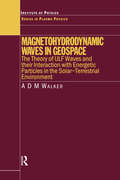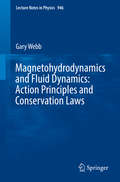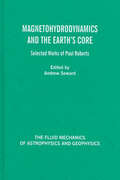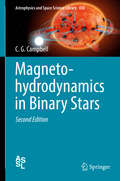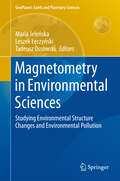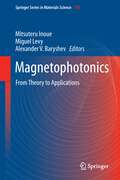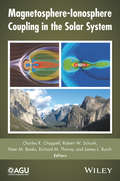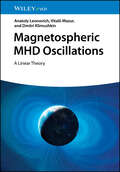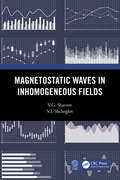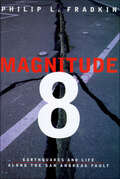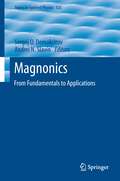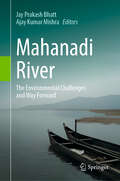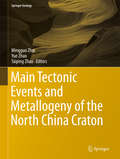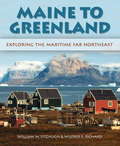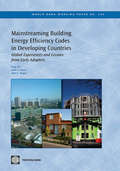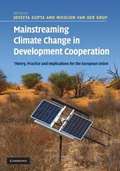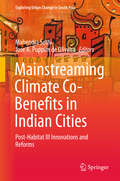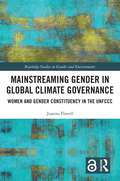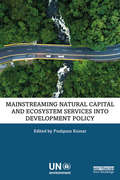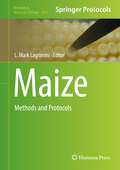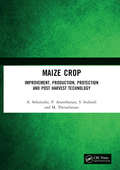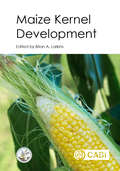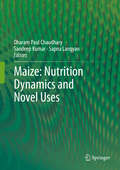- Table View
- List View
Magnetohydrodynamic Waves in Geospace: The Theory of ULF Waves and their Interaction with Energetic Particles in the Solar-Terrestrial Environment (Series in Plasma Physics)
by A.D.M. WalkerSolar-terrestrial physics deals with phenomena in the region of space between the surface of the Sun and the upper atmosphere of the Earth, a region dominated by matter in a plasma state. This area of physics describes processes that generate the solar wind, the physics of geospace and the Earth's magnetosphere, and the interaction of magnetospheri
Magnetohydrodynamics and Fluid Dynamics: Action Principles and Conservation Laws
by Gary WebbThis text focuses on conservation laws in magnetohydrodynamics, gasdynamics and hydrodynamics. A grasp of new conservation laws is essential in fusion and space plasmas, as well as in geophysical fluid dynamics; they can be used to test numerical codes, or to reveal new aspects of the underlying physics, e.g., by identifying the time history of the fluid elements as an important key to understanding fluid vorticity or in investigating the stability of steady flows. The ten Galilean Lie point symmetries of the fundamental action discussed in this book give rise to the conservation of energy, momentum, angular momentum and center of mass conservation laws via Noether’s first theorem. The advected invariants are related to fluid relabeling symmetries – so-called diffeomorphisms associated with the Lagrangian map – and are obtained by applying the Euler-Poincare approach to Noether’s second theorem. The book discusses several variants of helicity including kinetic helicity, cross helicity, magnetic helicity, Ertels’ theorem and potential vorticity, the Hollman invariant, and the Godbillon Vey invariant. The book develops the non-canonical Hamiltonian approach to MHD using the non-canonical Poisson bracket, while also refining the multisymplectic approach to ideal MHD and obtaining novel nonlocal conservation laws. It also briefly discusses Anco and Bluman’s direct method for deriving conservation laws. A range of examples is used to illustrate topological invariants in MHD and fluid dynamics, including the Hopf invariant, the Calugareanu invariant, the Taylor magnetic helicity reconnection hypothesis for magnetic fields in highly conducting plasmas, and the magnetic helicity of Alfvén simple waves, MHD topological solitons, and the Parker Archimedean spiral magnetic field. The Lagrangian map is used to obtain a class of solutions for incompressible MHD. The Aharonov-Bohm interpretation of magnetic helicity and cross helicity is discussed. In closing, examples of magnetosonic N-waves are used to illustrate the role of the wave number and group velocity concepts for MHD waves. This self-contained and pedagogical guide to the fundamentals will benefit postgraduate-level newcomers and seasoned researchers alike.
Magnetohydrodynamics and the Earth's Core: Selected Works by Paul Roberts (The Fluid Mechanics of Astrophysics and Geophysics)
by Andrew SowardPaul Roberts' research contributions are remarkable in their diversity, depth and international appeal. Papers from the Paul Roberts' Anniversary meeting at the University of Exeter are presented in this volume. Topics include geomagnetism and dynamos, fluid mechanics and MHD, superfluidity, mixed phase regions, mean field electrodynamics and the E
Magnetohydrodynamics in Binary Stars (Astrophysics and Space Science Library #456)
by C. G. CampbellMagnetism in binary stars is an area of central importance in stellar astrophysics. The second edition of "Magnetohydrodynamics in Binary Stars" is a major revision of the first edition. The material has been updated and extended, including additional chapters on the origins of the stellar magnetic fields and accretion disc magnetic winds. A comprehensive account is given of the subject, from the early work up to the latest results. The unifying theme remains the redistribution of angular momentum by magnetic stresses. This occurs in a wide variety of ways, including magnetic stellar and orbital coupling, magnetic channelling of accretion streams, magnetic stellar coupling to accretion discs, dynamo field coupling in discs, and magnetic stellar and disc winds. The associated stellar spin and orbital evolution problems, including stability, are also considered. Although the main focus is on binary stars, much of the work on accretion discs and wind flows has more general astrophysical relevance. Convenient formulae are included that can be compared to observations, making the book useful to observers as well as theorists, and there are extensive reference lists. The material is mainly aimed at research workers, but parts of the text could be useful for postgraduate courses in magnetic stellar astrophysics topics.
Magnetometry in Environmental Sciences: Studying Environmental Structure Changes and Environmental Pollution (GeoPlanet: Earth and Planetary Sciences)
by Maria Jeleńska, Leszek Łęczyński and Tadeusz OssowskiThe book offers a review of the work of the Polish Research Group on selected topics of environmental magnetism: the application of magnetic methods to study pollution of outdoor and indoor air, street dust, polluted soil, air filters and indoor dust; the use of magnetic properties to study pedogenic processes in soils and soil structure; as well as deposition processes in recent sediments. The authors focus on detailed cases and provide in-depth explanations of the causes of and relations between physical processes. The examples of different studies demonstrate how to apply magnetometry to solve problems in related disciplines, how to better understand the complexity of the magnetic structure of substances and mediums as well as how to trace interactions between the environment and natural and anthropogenic factors.
Magnetophotonics
by Alexander V. Baryshev Miguel Levy Mitsuteru InoueThis book merges theoretical and experimental works initiated in 1997 from consideration of periodical artificial dielectric structures comprising magneto-optical materials. Modern advances in magnetophotonics are discussed giving theoretical analyses and demonstrations of the consequences of light interaction with non-reciprocal media of various designs. This first collection of foundational works is devoted to light-to-artificial magnetic matter phenomena and related applications. The subject covers the physical background and the continuing research in the field of magnetophotonics.
Magnetosphere-Ionosphere Coupling in the Solar System
by Robert W. Schunk James L. Burch Richard M. Thorne Peter M. Banks Charles R. ChappellOver a half century of exploration of the Earth's space environment, it has become evident that the interaction between the ionosphere and the magnetosphere plays a dominant role in the evolution and dynamics of magnetospheric plasmas and fields. Interestingly, it was recently discovered that this same interaction is of fundamental importance at other planets and moons throughout the solar system. Based on papers presented at an interdisciplinary AGU Chapman Conference at Yosemite National Park in February 2014, this volume provides an intellectual and visual journey through our exploration and discovery of the paradigm-changing role that the ionosphere plays in determining the filling and dynamics of Earth and planetary environments. The 2014 Chapman conference marks the 40th anniversary of the initial magnetosphere-ionosphere coupling conference at Yosemite in 1974, and thus gives a four decade perspective of the progress of space science research in understanding these fundamental coupling processes. Digital video links to an online archive containing both the 1974 and 2014 meetings are presented throughout this volume for use as an historical resource by the international heliophysics and planetary science communities. Topics covered in this volume include: Ionosphere as a source of magnetospheric plasma Effects of the low energy ionospheric plasma on the stability and creation of the more energetic plasmas The unified global modeling of the ionosphere and magnetosphere at the Earth and other planets New knowledge of these coupled interactions for heliophysicists and planetary scientists, with a cross-disciplinary approach involving advanced measurement and modeling techniques Magnetosphere-Ionosphere Coupling in the Solar System is a valuable resource for researchers in the fields of space and planetary science, atmospheric science, space physics, astronomy, and geophysics.
Magnetospheric MHD Oscillations: A Linear Theory
by Anatoly Leonovich Dmitri Klimushkin Vitalii MazurMagnetospheric MHD Oscillations A groundbreaking new theory of the magnetosphere The magnetosphere is the region around Earth in which our planet’s magnetic field exerts its influence to trap charged particles. Waves in this magnetosphere, known as magnetohydrodynamic (MHD) oscillations, are caused by interactions between these charged particles, Solar wind pulses, and the magnetic field. The predictable interval between these oscillations enables them to serve as tools for understanding the magnetospheric plasma which comprises the field. Magnetospheric MHD Oscillations offers a comprehensive overview of the theory underlying these waves and their periodicity. Emphasizing the spatial structure of the oscillations, it advances a theory of MHD oscillation that promises to have significant ramifications in astronomy and beyond. Magnetospheric MHD Oscillations readers will also find: Theorizing of direct relevance to current satellite missions, such as THEMIS and the Van Allen Probe In-depth discussion of topics including Alfven resonance, waveguides in plasma filaments, and many more Detailed appendices including key calculations and statistical parameters Magnetospheric MDH Oscillations is ideal for plasma physicists, theoretical physicists, applied mathematicians, and advanced graduate students in these and related subfields.
Magnetostatic Waves in Inhomogeneous Fields
by V.G. Shavrov V.I. ShcheglovMagnetostatic waves (MSWs) in magnetodielectric media are fundamental for the creation of various highly efficient devices for analog information processing in the microwave range. These devices include various filters, delay lines, phase shifters, frequency converters, nonreciprocal and nonlinear devices, and others. Magnetostatic Waves in Inhomogeneous Fields examines magnetostatic waves and their distribution in non-uniformly magnetized films and structures. The propagation of magnetostatic waves in magnetodielectric environments is accompanied by numerous and very diverse physical effects, sharply distinguishing them from ordinary electromagnetic waves in isotropic media. The authors address dispersion properties and noncollinearity of phase and group velocity vectors, as well as non-reciprocal propagation. Key Features Offers mathematical tools used in the calculation of properties of magnetostatic waves Includes a current literature review of magnetostatic waves and domain structures in garnet–ferrite films Considers the issue of converting magnetostatic waves into electromagnetic ones
Magnetothermal Properties near Quantum Criticality in the Itinerant Metamagnet Sr3Ru2O7
by Andreas W RostThe compound Sr3Ru2O7 of the strontium ruthenate family has been intensely studied because experimental evidence suggests that quantum fluctuations dominate the magnetic phase diagram in the vicinity of a novel low-temperature phase. In order to understand the interplay between the quantum critical fluctuations and the phase formation, comprehensive thermodynamic information is essential. This thesis reports the results of both specific-heat and magnetocaloric experiments carried out with a bespoke experimental apparatus whose design particularly addresses the demanding constraints of the low-temperature, high-magnetic-field environment. The experimental data give evidence for unusual thermodynamic properties of the novel phase and its bounding phase transitions. Furthermore they show that the phase formation takes place against a background of strongly peaking entropy, suggesting that quantum criticality plays a key role in the physics of this system.
Magnitude 8: Earthquakes and Life Along the San Andreas Fault
by Philip L. FradkinMagnitude 8 is the archetypal natural disaster defined. To understand the cataclysmic earthquake that will tear California apart one day, Philip L. Fradkin has written a dramatic history of earthquakes and an eloquent guide to the San Andreas Fault, the world's best-known tectonic landscape. The author includes vivid stories of earthquakes elsewhere: in New England, the central Mississippi River Valley, New York City, Europe, and the Far East. Always, he combines human and natural drama to place the reader at the epicenter of the most instantaneous and unpredictable of all the Earth's phenomena. Following the San Andreas Fault from Cape Mecino to Mexico--canoeing the fault line in northern California and walking underground through the Hollywood fault--noted environmental historian Philip L. Fradkin reclaims the human dimensions of earthquakes from the science-dominated accounts.
Magnonic Devices: Numerical Modelling and Micromagnetic Simulation Approach (SpringerBriefs in Materials)
by C. S. Nikhil KumarThis book briefly looks at numerical modeling and micromagnetic simulation results of magnonic crystals, which are periodically modulated magnonic devices regarded as the magnetic counterpart of photonic crystals with spin waves acting as the information carrier. Since the wavelength of the spin wave is several orders of magnitude shorter than that of electromagnetic waves of the same frequency, magnonic crystals are promising candidates for miniaturization, especially in the fields of data storage and processing. The book begins by describing the dispersion relation of dipolar spin waves in a magnonic curved waveguide, solving Walker's equation in cylindrical coordinates, and then calculating the dispersion of exchange spin waves using perturbation theory. It describes simulated nano-contact-driven spin wave excitations in a magnonic cavity, featuring a design of an antidot magnonic crystal around the nano-contact, with the frequency of the spin wave mode generated lying within the band gap of the magnonic crystal. The proposed device behaves as a SWASER—Spin Wave Amplification by the Stimulated Emission of Radiation. This book will find interest among researchers and practitioners interested in the modeling, simulation, and design of novel magnonic devices.
Magnonics: From Fundamentals to Applications
by Andrei N. Slavin Sergej O. DemokritovSpin waves (and their quanta magnons) can effectively carry and process information in magnetic nanostructures. By analogy to photonics, this research field is labelled magnonics. It comprises the study of excitation, detection, and manipulation of magnons. From the practical point of view, the most attractive feature of magnonic devices is the controllability of their functioning by an external magnetic field. This book has been designed for students and researchers working in magnetism. Here the readers will find review articles written by leading experts working on realization of magnonic devices.
Mahanadi River: The Environmental Challenges and Way Forward
by Ajay Kumar Mishra Jay Prakash BhattThis book covers an overview of the Mahanadi River basin, spanning a total area of 141,581 square kilometers and extending across the states of Chhattisgarh (52.42%), Odisha (47.14%), Maharashtra (0.23%), Madhya Pradesh (0.11%), and Jharkhand (0.1%). It delves into the basin's hydro-development scenario, biodiversity, water quality, and sand mining, elucidating the pivotal role of the river in economic, social, and environmental viability of the eastern region of India. This volume emphasizes the environmental consequences stemming from unsustainable human activities such as river regulation, burgeoning settlements, sand mining, overfishing, and more. The Mahanadi River basin has been less explored for its biodiversity and environmental aspects compared to other prominent river basins like Ganga, Indus, Western Ghats, Godavari, and Krishna. This book seeks to fill this gap, offering new insights into the Mahanadi basin. The chapters address all dimensions of the environment, including social, ecological, engineering, and economic aspects, making it a multidisciplinary work. The book is tailored for audiences with backgrounds in social studies, engineering, biodiversity, and ecology.
Main Tectonic Events and Metallogeny of the North China Craton
by Mingguo Zhai Yue Zhao Taiping ZhaoThis book focuses on the metallogeny and main tectonic events of the North China Craton from early Precambrian to Phanerozoic. It covers the Archean crustal growth, Paleoproterozoic rifting-subduction-collision processes, Great Oxidation Event, Meso-Neoproterozoic multiple rifting, Phanerozoic reworking of the North China Craton, as well as metallogeny related to above different processes. The North China Craton is one of the oldest cratons in the world. It has experienced a complex geological evolution since the early Precambrian, and carries important records of secular changes in tectonics and metallogeny. It provides a systematic review and new results on the growth and evolution of the North China Craton and metallogeny. It will be of broad interest to the earth scientists working in the fields of economic geology, geochemistry, and tectonics of the North China Craton and eastern Asian.
Maine to Greenland
by William Fitzhugh Wilfred E. RichardMaine to Greenland is a testament to one of the world's great geographic regions: the Maritime Far Northeast. For more than three decades, William W. Fitzhugh and Wilfred E. Richard have explored the Northeast's Atlantic corridor and its fascinating history, habitat, and culture. The authors' powerful personal essays and Richard's stunning photography transport readers to this vibrant region, joining Smithsonian archaeological expeditions and trekking in vast and amazing terrain. Following Fitzhugh and Richard's travels north--from Maine to the Canadian Maritimes, Newfoundland and northern Quebec, then to Labrador, Baffin and Ellesmere islands, and Greenland--we view incredible landscapes, uncover human history, and meet luminous personalities along the way. Fully illustrated with 350 full-color photographs, Maine to Greenland is the first in-depth treatment of the Northeast Atlantic corridor and essential for armchair travelers, locals, tourists, or anyone who has journeyed there. Today green technology, climate change, and the opening of the Arctic Ocean have transformed the Maritime Far Northeast from an icy frontier into a global resource zone and an increasingly integrated international crossroads. In our rapidly converging world, we have much to learn from the Maritime Far Northeast and how its variety of cultures have adapted to rather than changed their environments during the past ten thousand years. Maine to Greenland is not only a complete account of the region's unique culture and environment, but also a timely reminder that amidst the very real consequences of climate change, the inhabitants of the Maritime Far Northeast can show us grounded and sustainable ways of living.
Mainstreaming Building Energy Efficiency Codes in Developing Countries
by Anke S. Meyer Feng Liu John F. HoganUrbanization and growing wealth in developing countries portend a large increase of demand for modern energy services in residential, commercial and public-service buildings in the coming decades. Pursuing energy efficiency in buildings is vital to energy security in developing countries and is identified by the Intergovernment Panel on Climate Change as having the greatest potential for cost-effective reduction of CO2 emissions by 2030 among all energy-consuming sectors. Building energy efficiency codes (BEECs), along with energy efficiency standards for major appliances and equipment, are broadly recognized as a necessary government intervention to overcome persistent market barriers to capturing the economic potential of energy efficiency gains in the residential, commercial and public-service sectors. Implementation of BEECs help prevent costly energy wastes over the lifecycles of buildings in space heating, air conditioning, lighting, and other energy service requirements. Nonetheless, achieving the full potential of energy savings afforded by more energy-efficient buildings requires holding people who live or work in buildings accountable for the cost of energy services. Compliance enforcement has been the biggest challenge to implementing BEECs. This report summarizes the findings of an extensive literature survey of the experiences of implementing BEECs in developed countries, as well as those from case studies of China, Egypt, India, and Mexico. It also serves as a primer on the basic features and contents of BEECs and the commonly adopted compliance and enforcement approaches. This report highlights the key challenges to improving compliance enforcement in developing countries, including government commitment to energy efficiency, the effectiveness of government oversight of the construction sector, the compliance capacity of building supply chain, and financing constraints. The report notes that the process of transforming a country's building supply chain toward delivering increasingly more energy-efficient buildings takes time and requires persistent government intervention through uniformly enforced and regularly updated BEECs. The report recommends increased international support in strengthening the enforcement infrastructure for BEECs in middle-income developing countries. For low- and lower-middle-income countries, there is an urgent need to assist in improving the effectiveness of government oversight system for building construction, laying the foundation for the system to also cover BEECs.
Mainstreaming Climate Change in Development Cooperation
by Joyeeta Gupta Nicolien van der GrijpClimate change, development and development cooperation are, individually and jointly, three politically sensitive, complex issues, especially in the context of relations between developed and developing countries. This book tackles these issues by combining theoretical, political, and practical perspectives, analysing the dominant paradigms and exploring the meaning of the concept of mainstreaming. At the practical level, it presents the results of case studies focusing on assistance provided by the European Union and key member states and the climate needs articulated by developing countries. At the political level, it highlights the sensitivities between developed and developing countries and examines the mainstreaming debate in various fora. This book is valuable for policymakers, academics, politicians and non-state actors working in the fields of development studies, international law, politics, international relations, economics, climate change, and environmental studies.
Mainstreaming Climate Co-Benefits in Indian Cities: Post-Habitat III Innovations and Reforms (Exploring Urban Change in South Asia)
by Mahendra Sethi Jose A. Puppim de OliveiraThis volume presents a novel framework to understand urban climate co-benefits in India, that is, tackling climate change and achieving sustainable development goals in cities. It utilizes methods and tools from several assessment frameworks to scientifically evaluate sector co-benefits for informed decision making. The co-benefits approach can lead to significant improvements in the way societies use environmental resources and distribute their outputs. The volume discusses four main themes: (1) Concepts and theories on cities and climate co-benefits; (2) Contextualizing co-benefit issues across spatial scales and sectors; (3) Sectoral analyses of co-benefits in energy, transport, buildings, waste, and biodiversity, and (4) Innovations and reforms needed to promote co-benefits in cities. The discussions are based on empirical research conducted in Indian cities and aligned with the international discourse on the 2030 UN Development Agenda and New Urban Agenda created at the UN-Habitat III in 2016. The analyses and recommendations in this volume are of considerable interest to policy experts, scholars and researchers of urban and regional studies, geography, public policy, international development/law, economics, development planning, environmental planning, climate change, energy studies, and so on.
Mainstreaming Gender in Global Climate Governance: Women and Gender Constituency in the UNFCCC (Routledge Studies in Gender and Environments)
by Joanna FlavellThis book explores the role of feminist activists in The United Nations Framework Convention on Climate Change and highlights the progress they have made in mainstreaming gender as a key issue in global climate governance. It is now commonplace for gender to be framed as a political issue in global climate politics within academic scholarship, but there is typically a lack of robust empirical analysis of existing advocacy approaches. Filling this lacuna, Joanna Flavell interrogates the political strategies of the Women and Gender Constituency (WGC) in the UNFCCC (The United Nations Framework Convention on Climate Change). Through a conceptual framework that integrates climate change with intersectional critical inquiry and political practice, Flavell analyses hundreds of historical documents, coupled with interviews and observations from two UNFCCC conferences. This research uncovers a so-far untold story about the history of the UNFCCC that foregrounds gender and feminist advocacy, highlighting the importance of the WGC in shaping dominant narratives of global climate governance through a series of rhetorical and procedural strategies. Overall, the book draws important conclusions around power in global climate governance and opens up new avenues for advancing a feminist green politics. This volume will be of great interest to students and scholars of environmental justice, climate politics and governance, environmental activism, and gender studies more broadly.
Mainstreaming Natural Capital and Ecosystem Services into Development Policy
by Pushpam KumarThis book highlights the latest advances in the science and practice of using ecosystem services to inform decisions for economic development in the context of the developing countries. The development of the ecosystem services paradigm has enhanced our understanding of natural capital as an indispensable form of capital asset along with produced and human capital. This book addresses what could be the possible pathways to mainstream natural capital assets into development policies and what is currently known about the economic values of ecosystem services. A series of innovative tools to help policy makers and planners account for natural capital and ecosystem services in sectoral and macroeconomic policies have been explored and their application at the national and regional scale has been demonstrated. Several detailed case studies are presented in which the understanding of ecosystem services values has successfully informed decisions, including examples from Chile, South Africa, Tanzania, Trinidad and Tobago, Vietnam and the Aral Sea in Central Asia. These provide the critically important insights, lessons learned and means and mechanisms for policy makers to incentivize protection and discourage degradation of ecosystems and the services they provide. Mainstreaming Natural Capital and Ecosystem Services into Development Policy is designed to help decision makers at all levels, including governments, businesses, multilevel development banks and individuals to integrate ecosystems and their services into their decision making.
Maize
by L. Mark LagriminiThis volume discusses techniques used for the molecular characterization of maize. This book is divided into 4 parts: cell, tissue, and organ culture and maize transformation; gene silencing and generation of mutant populations; plant gene expression; and plant metabolic networks. The chapters cover a range of topics, such as growing and propagating maize in the laboratory, greenhouse and field studies, screening mutagenic population, characterizing the genome, describing protein and metabolic regulatory networks, and generating transgenic plants for gene knock-out and over expression purposes. Written in the highly successful Methods in Molecular Biology series format, chapters include introductions to their respective topics, lists of the necessary materials and reagents, step-by-step, readily reproducible laboratory protocols, and tips on troubleshooting and avoiding known pitfalls. Cutting-edge and comprehensive, Maize: Methods and Protocols is a valuable resource for everyone who is interested in maize research.
Maize Crop: Improvement, Production, Protection and Post Harvest Technology
by A. Solaimalai P. Anantharaju S. Irulandi M. TheradimaniMaize is one of the versatile emerging crops with wider adaptability under varied agro-climatic conditions. Globally, maize is known as queen of cereals because it has the highest genetic yield potential among the cereals. It is cultivated on nearly 150 m/ha in about 160 countries having wider diversity of soil, climate, biodiversity and management practices that contributes 36 % (782 m/t) inthe global grain production. The United States of America (USA) is the largest producer of maize contributes nearly 35 % of the total production in the world. It is the driver of the US economy. This book talks about the improvement, production, protection and post harvest technology of the maize crop. Note: T& F does not sell or distribute the Hardback in India, Pakistan, Nepal, Bhutan, Bangladesh and Sri Lanka.
Maize Kernel Development
by Bo Shen Alan Meyers Sherry Flint-Garcia Matthew Evans Philip Becraft Jim Birchler Ljudmilla Borisjuk Prem S. Chourey Joanne Dannenhoffer José Gutiérrez-Marcos Jeff Habben Curt Hannah Tracie Hennen-Bierwagen Gregorio Hueros Gwyneth Ingram Shawn Kaeppler Karen Koch Dr Brian A Larkins Fangfang Ma Don McCarty Jo Messing Keith Roesler Hardy Rolletschek Paolo Sabelli Jeff Schussler Bill Sheridan Rentao Song Erik Vollbrecht Thomas Widiez Yongrui Wu Ramin Yadegari Junpeng ZhanThis is an authoritative book that acts as a guide to understanding maize kernel development. Written by a team of experts, it covers topics spanning pre- and post-fertilization events, embryo and endosperm development, grain filling and maturation, and factors influencing crop yield. It explores the significance of maize and other cereal grains, existing hypotheses and research, and important gaps in our knowledge and how we might fill them. This is a valuable resource for researchers of maize and other cereals, and anyone working on basic or applied science in the fields of seed development, plant genetics, and crop physiology.
Maize: Nutrition Dynamics and Novel Uses
by Sandeep Kumar Dharam Paul Chaudhary Sapna LangyanMaize is a globally important crop mainly utilized as feed, food and raw material for diverse industrial applications. Among cereals, it occupies third place after rice and wheat and is a staple food for a large segment of population worldwide particularly in the Asian as well as African countries. This monogram discusses various aspects of nutritional quality of maize such as quality protein maize which has been considered as most significant discovery in enhancing nutritional quality of cereals in terms of increasing the concentration of essential amino acids. The biochemistry of starch which is an important industrial product of maize has been discussed in detail. Further, the role of maize oil which is highly regarded for human consumption as it reduces the blood cholesterol concentration has also been elaborated. Naturally, maize is a rich source of carotenoids such as beta-carotene, zeaxanthin, lutein, cryptoxanthin which have highly diverse health benefits ranging from maintaining normal vision to lowering of oxidative stress. The need for biofortification of maize for provitamin A carotenoids and their role in alleviating vision impairments have also been discussed. The effect of various biotic and abiotic stresses particularly carbon dioxide and temperature on quality has been discussed thoroughly. Many value-added products as well as fermented foods that have been produced from maize which is consumed in different forms worldwide are also discussed. The aspects related to the maize application as fodder and as a source of malting have also been covered concisely. Overall, the book provides complete information about various quality aspects of maize. The various stakeholders such as maize researchers, extension specialists, students, teachers as well as farmers will be immensely benefitted from this monogram.
